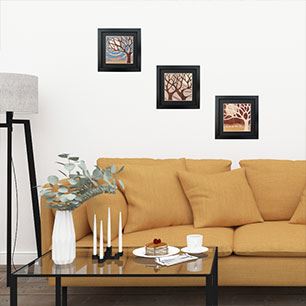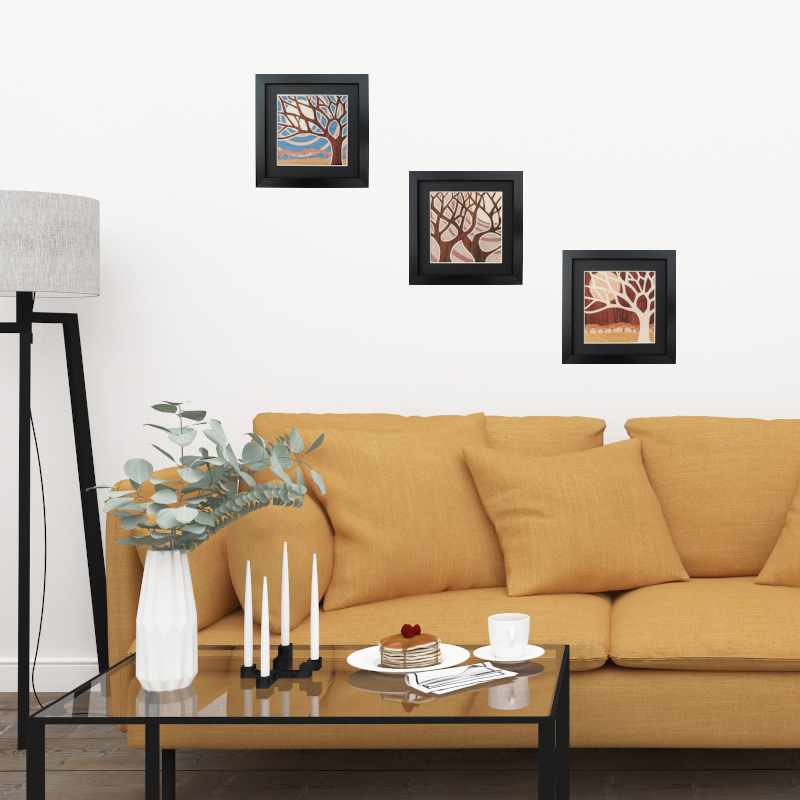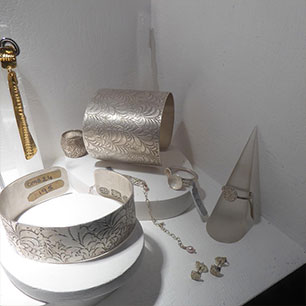
Introducing Lisbeth Moon – The Artist Behind Pressed Floral Art
Earlier this week I met with one of Handmade in Britain’s member artists, Lisbeth Moon – AKA Pressed Floral Art, at her workshop in Crouch End, London. Lis designs botanical works of art made from real pressed flowers, using a professional hand-pressing technique that preserves the flowers’ natural vivacity. Her work aims to celebrate and admire nature, and it comes from a deep love of gardening and botanical research. Each piece is originally arranged using her own hand-pressed flowers, and from there it’s photographed professionally, blown up, and giclee printed onto fine art paper. She selects all of her flowers according to the seasons, from her own garden, from florists, or from the British wilderness, and everything is done sustainably and with permission.
As I make myself comfortable in her bright and airy studio, Lisbeth starts to show me some of her beautiful pieces and talks to me about her artistic process –
What we do is I take the original pressings, and then I pass them on to my photographer, David Wilmann. I’m lucky to find him and I am not letting him go – he’s amazing.
I love this colour.
These are Anemones, aren’t they stunning? I’ve got a whole load of new ones in the press – pink, scarlet, red. Just incredible and this is like two years later. So I know now that my pressing process works really well. It was a year of research before I started to make anything. Just pressing, learning and seeing, and getting a feel for it, and getting that process down until I was happy with it, and I took it from there.
So what I do is, I’ll go through, and I tend to the presses every day, and I’ve got two more presses coming tomorrow. I want to press where I’m running out of presses, so I have to keep ordering more. I’ll have about five or six presses, large A3 size ones on the go at any one time. Which is quite a lot of flowers.
The idea of pressing is that you want to remove the moisture as quickly as you can, you don’t want them sitting on the damp paper. So I swap out the paper every day for the first few days, depending on the type of flower, some need to be managed for a week. Others only need two or three days. Depends, on how dry or wet the actual flower itself is. These are a medium kind of depth, but they’ve got quite a bulky middle bit so that there’s quite a lot of moisture in there and the same with these. That’s why I’m waiting for them. Just to open up a bit more, so they don’t clump.
So, I’ll do that every day, probably from about March to December, and then there’s a little bit of a gap from December to February. So there’s not much happening then, except if I’m doing green or foliage or something like that.
So, how long do you have to leave them?
I tend to them every day for the first week and then I leave them for three to four weeks. And then they’re pressed when they feel papery and they kind of stand up on their own. You just learn how to feel it, and then they’re ready and then they can be worked with.
So, I’m doing the pressing now. And I’m gonna spend the week designing or two weeks or whatever it is, then I design as quickly as I can, and then I get to the photographer with those originals and then he sets it up. So he takes the photograph from overhead so that they’re flat, and he’s got all of our lighting sorted out.
Whenever I come we have the same setup and we’ve worked through about seven or eight sessions. The first ones we were like, “No, that’s too pinky, the background – it’s not quite right”. So we’ve nailed how the look should be and the feel of the print, and then he does his magic – whatever he does digitally – and he colour calibrates it so that the colour of the original is calibrated to the colour of the digital artwork, then we’ll resize it according to the sizes that I want to print them in, and then I print to order. I’ll always have one or two of each print, but on the whole my business model is print-to-order.
Otherwise, I just keep a whole lot of stock, and that gets impossibly hard to manage.
What do you think it is about nature that makes it so compatible with, and inspiring, to creators such as yourself?
That came really easy. Nature is the artist I wanted. I remember saying something in one of my workshops – nature is the artist, I’m just a good glue to mount it. It was here long before us and here long after us. And for me, anything you could ever want creatively and inspirationally is in nature. I think that’s why people are so attracted to it. The colour, the shape, the form, the texture, the endurance, and the sheer wonder, every way a plant will always find its way.
I mean, I now look at everything really differently. Since I started pressing, everything is like – how will that look one-dimensional now? I don’t even see it as the flower anymore and when I’m walking about I always have my snips in my pocket. You’ll find me on the street corner – ‘come see the weeds!’ – that kind of thing.
Nature is what it’s about. It’s just that shape, and that form and the colours. The whole thing. The only other thing I was thinking about is architecture probably has a similar thing for creative people – the lines and the shapes and the geometry.
There are a lot of people inspired by architectural form, but for me, it’s the natural form and it’s not about angular squares, it’s all about soft edges, and also the imperfectness of it and the perfectness of it.
So for me, it’s about preserving a fleeting beauty. And I think that’s what started me with it.
And what first inspired you to start working with flowers?
Well, I’ve been an amateur gardener for a long time. I’ve nurtured and grown about four quite large gardens, and about three roof terraces over the years. I’ve got a roof terrace and I use my friend’s garden. So I’ve got a lot of things growing in her garden. I go up there and I pick because I don’t have a garden here and I’m a bit late on my terrace. I haven’t done my seeds and things yet. Luckily I’ve got a lot of perennials, so what I had last year is regrowing.
The attachment is really strong. I don’t know what it’s about, but I know my friends who grow vegetables and things in their gardens, they’re really attached to their vegetables.
Cherry blossom is gone in a few minutes, it blows away and that’s it. And I’m not trying to go against nature, because nature has a cycle – it dies and comes back, but it’s more about preserving that moment of fleeting beauty. And I don’t know, the pressing just came and I took it from there. And I found myself being quite military and wanting every flower to be really seen and felt. So it ended up being these quite strategic lines of flowers, especially with the miniatures where otherwise it just feels messy and I can’t handle it.
It’s interesting because nature is very organic with curved lines and everything. And then the approach you’ve taken to displaying it is, as you say, quite military.
It’s funny, I often question myself about that.
But somehow it’s just what I do. So it’s about colour, texture, shape, form, and season and I’m often looking at the negative space. What’s the negative space doing? And I quite like the fact that it’s there’s quite a lot of negative space that it’s not just a busy wallpaper.
And so, what kind of a person is it that you imagine you make your products for?
For me, it’s like, well, who doesn’t love a flower, whether you actually want to hang it on your wall, is it a different thing? But, I think my typical audience is people who are restyling or redecorating.
So, when I was selling at the market, there were a lot of couples having conversations about their colour scheme – two different sets of people. One had just bought a rental cottage and they were doing it up and they didn’t want to have real flowers. So they were like – this is perfect.
I think it’s about redecorating and about restyling or just thinking about what colour scheme you might want on your wall or the type of flowers, you love.
And then I guess it’s also Chelsea Flower Show customers, Gardeners, and people who just love colourful, cheerful art. I’ve started hanging my art everywhere, and I have to say, it makes me feel happy.
I was also quite surprised at the market that there were quite a lot of men who were saying to their partners “Oh, look at this.” I’d always thought this was very female-orientated, but I think there is a smaller male audience, who also appreciate a bit of colour and form.
And who and what are your biggest influences?
We’ve covered it in nature, but I’ve also read lots of notebooks and diaries of 19th-century botanists and naturalists like Darwin and Humboldt, and I’m absolutely obsessed.
So they’re really inspirational. I mean that is just like my dream world and life. I wish I was born in the 1800s. I think I’m in the wrong era. And then people like Beth Chateau, I don’t know if you’ve heard of her? She was an amazing gardener and she has gardens in Essex. She wrote the garden notebook for people like her and all sorts of gardeners and nature writers and naturalists. So that’s where it’s all drawn from. So it’s really about the historic and the scientific kind of angle of nature.
I do follow some people on Instagram and everything but mostly it’s about gardening and the growers and the people that are out there doing incredible stuff through fighting for nature’s life. And I really feel like I’m fed up, I’ve really reached the end of my tether with that now, just leave nature alone. I mean, I just read now, Plymouth cut down loads of mature trees in the city centre to make way for what we all want, more retail and more flats or flats. It’s just like enough. 150 trees were just chopped down in the name of concrete.
Have you always been artistic from an early age or was this something you began doing later on in life?
I’ve always done something. Yeah, I’ve always gone to art classes – portraits, still life. I did a lot of drawing early on.
I did use to make botanical silver jewellery. And actually, that was also the point where I decided, why am I recreating this in silver? I’m sitting here with the flower making this botanical pendant. Why am I working with the real thing?
So, yes, it’s beautiful in a different way, so it kind of went from there. So, yeah, it’s always been something you’ve been some outlook, but this now is it. Yeah, I’ve landed. It’s taking me quite a few paths to get there – I did a bit of ceramics and glass blowing and glass fusing and tried a few different things. But I’ve landed. This is it. Some people are lucky and they find that immediately.
It’s nice going on the journey, though.
Yes, figuring it out.
You can shop all of our Pressed Floral Art designs here.
















